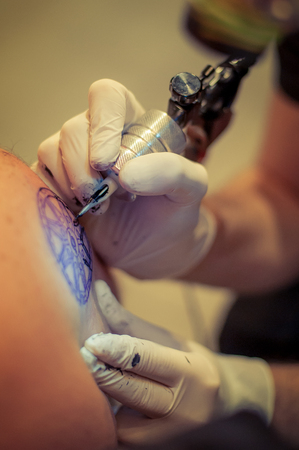Introduction: Why Brits Choose Laser Tattoo Removal
Tattoos have long been woven into the fabric of British culture, from the maritime ink of sailors in Portsmouth to the bold statements seen on London’s high streets. Yet, as times and tastes change, so too do our feelings about the art we carry on our skin. In the UK, an increasing number of people are choosing laser tattoo removal—a decision that often comes with its own set of personal stories and motivations. Whether it’s a matter of erasing a youthful impulse, preparing for a new career path, or simply wanting a fresh start, British clients approach tattoo removal with unique perspectives shaped by local attitudes. Across cities and countryside alike, there’s a growing openness about making changes, reflecting a broader cultural shift towards self-expression and reinvention. Through real stories shared by clients across Britain, we’ll explore what truly motivates individuals to seek out laser tattoo removal and how their experiences reflect wider trends in British society.
Hannah’s Story: Fading the Past to Embrace the Future
Meet Hannah, a 32-year-old marketing consultant living in the heart of London. Like many young people, she once saw tattoos as a bold way to express herself during university days. However, as her career progressed and her lifestyle changed, Hannah found herself reconsidering the large script tattoo on her forearm—a remnant from a time when life felt less complicated.
For Hannah, the motivation to pursue laser tattoo removal was multifaceted. She shared, “I wanted my appearance to reflect who I am now, not who I was at 19. In meetings with clients and colleagues, I often felt self-conscious about my tattoo peeking out from under my sleeves.” The decision didn’t come lightly; it was about reclaiming confidence and opening up new professional opportunities without feeling judged.
Before booking her first session, Hannah researched several clinics across London. She paid particular attention to reviews by other British clients, prioritising those that mentioned qualified practitioners and CQC registration—a must in the UK for peace of mind. Her expectations were realistic: she knew that fading such a prominent tattoo would take time and commitment.
| Aspect | Hannah’s Expectations | Reality After First Session |
|---|---|---|
| Pain Level | Mild discomfort, like an elastic band snap | Tolerable but sharper than expected; manageable with numbing cream |
| Time Commitment | Several sessions over months | Treatment lasted just minutes; recovery required gentle aftercare |
| Visible Results | No immediate change anticipated | Slight whitening and swelling; subtle fading visible after two weeks |
| Professionalism | Friendly, supportive staff | Clinic team offered detailed guidance and reassurance throughout |
Reflecting on her first impressions, Hannah noted how modern British clinics have elevated client care: “I loved that they offered a proper consultation beforehand. Everything felt very above board—very British in their thoroughness.” The process wasn’t pain-free, but it was empowering. With each visit, she felt closer to aligning her outward image with her current self.
![]()
3. First Impressions: The Initial Consultation Experience
For many British clients, the very first step into a laser tattoo removal clinic comes with a mix of nerves and curiosity. There’s often a sense of apprehension—will it hurt? Is it safe? Will I be judged for my tattoo choices? Real stories from across the UK reveal that these concerns are met with genuine understanding and warmth from practitioners.
Clients recall walking into clinics in London, Manchester, or Edinburgh, expecting clinical coldness but instead finding inviting reception areas and staff who greet them with a friendly “Alright, love?” or “How can we help today?” This small touch of British hospitality immediately sets the tone. During consultations, practitioners take time to listen without judgement—whether it’s a faded football crest or an ex’s name that’s up for removal. Clients mention how UK specialists explain each stage thoroughly, using plain English and even local humour to put people at ease.
Several shared how initial anxieties melted away as soon as they realised the practitioner’s professionalism went hand-in-hand with kindness. Consultations typically involve assessing the tattoo, discussing realistic outcomes, and being upfront about costs and aftercare—all without pressure. One client from Birmingham described feeling “reassured by the honest advice and clear answers,” while another in Glasgow appreciated the practitioner’s patience in answering every question, no matter how trivial it seemed.
Ultimately, British clients agree that their first impressions during consultations were positive and reassuring. It’s not just about removing ink; it’s about trust, respect, and genuine care—a uniquely British approach that makes all the difference when starting the journey to clear skin.
4. The Process: Pain, Progress and Patience
When it comes to laser tattoo removal, most Brits will tell you straight: it’s not a walk in the park. As one London client, Sarah, put it, “It’s more of a sharp elastic snap than a burning pain—uncomfortable, but definitely manageable.” The sensation varies from person to person, but generally, clients describe the feeling as a rapid flick or hot pinpricks on the skin.
Pain Levels Across Sessions
| Session | Pain Level (1-10) | British Description |
|---|---|---|
| First Session | 7 | “Bit of a shock to the system, like being snapped by a rubber band.” |
| Second Session | 6 | “You know what’s coming, so it’s less daunting.” |
| Later Sessions | 4-5 | “More of an annoying tingle—almost got used to it!” |
The aftercare routine is just as crucial as the treatment itself. Most clinics across the UK advise keeping the area clean and dry, using a gentle moisturiser or aloe vera gel, and avoiding direct sun exposure. As Tom from Manchester shared, “I’d slap on some Savlon and keep my arm out of the sun. Simple as that.” You might also experience slight swelling or redness for a day or two—nothing too dramatic if you stick to the advice.
The Waiting Game: Patience Is Key
The real challenge? Patience. British clients often emphasise how important it is to wait between sessions—usually six to eight weeks—to allow your skin to heal and your body to flush out the ink. “At first I wanted it gone pronto,” said Jess from Bristol, “but you quickly learn it’s not a quick fix. Good things come to those who wait!” This gradual process allows for better fading and reduces risks of scarring.
5. Aftercare & Local Tips
When it comes to laser tattoo removal in the UK, aftercare is just as crucial as the treatment itself. From chatting with fellow Brits who’ve gone through it, I’ve gathered some community wisdom and practical advice that truly reflects our local culture—and unpredictable weather! Here’s what you need to know for a smooth recovery.
Essential Aftercare Products from Your Local Chemist
Nearly every British client I spoke to swore by popping into their nearest Boots or Superdrug post-session. Antibacterial ointments like Savlon and gentle, fragrance-free moisturisers are absolute must-haves. Many recommended picking up non-stick dressings (look for brands like Melolin) and microporous tape for secure yet gentle coverage—especially handy if your treated area is likely to rub against clothing.
Clever Ways to Keep It Covered
Discretion can be key, particularly if you’re back at work or out in public soon after treatment. One Londoner shared how she used lightweight scarves and long sleeves to hide healing skin during springtime commutes. Another tip? A simple plaster or breathable bandage does wonders—not just for protection but also for avoiding curious questions!
Navigating the Great British Weather
Our infamous weather brings its own aftercare challenges. Rainy days mean extra care to keep dressings dry—waterproof plasters are a lifesaver. On rare sunny days, SPF 50 is your new best friend; every Brit I spoke to stressed slathering it on religiously since UV exposure can worsen pigmentation issues post-laser. If you’re headed outdoors, a wide-brimmed hat or even a classic brolly offers added protection (and a bit of British flair!).
Ultimately, the most valuable advice comes from those who’ve been there: listen to your practitioner, lean on your local chemist for supplies, and never underestimate the power of our uniquely British resourcefulness when it comes to aftercare.
6. Results Unveiled: Reflecting on Choices and Confidence
The moment of truth arrives as British clients see the gradual fading of their tattoos, and for many, it’s nothing short of transformative. Each session brings subtle changes, but over time, the results speak volumes. For some, it’s about reclaiming a part of themselves that felt overshadowed by ink they’d outgrown. “Every week I noticed my tattoo softening,” shares Sarah from Manchester, “and with each change, I felt lighter—almost as if I was finally letting go of old memories.”
As the colours diminish and lines blur, confidence quietly grows. James from Bristol explains, “I used to hide my arm at work, but now I’m not embarrassed at all. My colleagues have noticed how much more comfortable I seem.” For these clients, laser tattoo removal isn’t just about erasing ink; it’s about making peace with the past and embracing a sense of freedom.
This journey often sparks a deeper reflection on self-image. Many describe feeling empowered by their decision to start anew—a fresh canvas and a renewed sense of self-worth. It’s common to hear stories of people who once regretted their tattoos now looking in the mirror with pride. There’s something beautifully British about this understated transformation: quiet determination paired with an appreciation for second chances.
For those who’ve been through it, the experience is both practical and emotional. As Hannah from Edinburgh puts it, “It wasn’t just about removing ink—it was about finding myself again.” Their stories serve as gentle reminders that it’s never too late to rewrite your narrative and step forward with confidence.
Advice from the UK Community
When it comes to laser tattoo removal, nothing beats hearing honest advice from fellow Britons who have walked the same path. Here’s what some of our UK clients wish they’d known – and what they want to share with you.
Managing Your Expectations
Many emphasise that patience is key. “It’s not a quick fix,” says Sophie from Manchester. “I needed six sessions and my tattoo faded gradually. Don’t expect it to vanish overnight.” Others echo this, reminding newcomers that factors like ink colour, tattoo age, and skin type play big roles in the final outcome. “Go in with an open mind and realistic goals,” advises Tom in Bristol.
Picking the Right Clinic
The British community recommends doing your homework when choosing a clinic. “Look for somewhere registered with the Care Quality Commission or local authority,” suggests Amira in London. Many stress the value of reading reviews and even visiting for a consultation first. “You should feel comfortable asking questions – a good practitioner will be happy to explain everything,” says Josh from Leeds.
Feeling at Ease in British Tattoo Culture
There’s no shame in changing your mind about your ink, as many pointed out. “Tattoo culture here is so diverse – people are understanding whether you’re adding new art or saying goodbye to old designs,” shares Lucy in Glasgow. The supportive environment can help ease any nerves about starting the process.
Supportive Words from Those Who’ve Been There
Above all, those who’ve experienced laser tattoo removal encourage others not to worry alone. “Speak to people who’ve done it, join UK forums, and don’t be afraid to seek support if you’re feeling anxious,” says Ben in Birmingham. From personal experience, most agree: the journey is worth it for renewed confidence and fresh beginnings.

